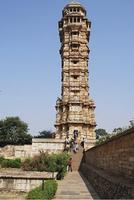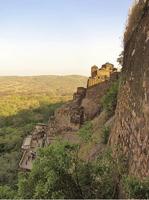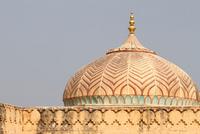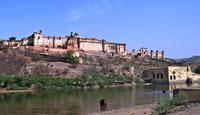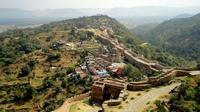You are in: Asia -> India -> Hill Forts of Rajasthan, and traditional search or Image Gallery will yield results of this site only
Hill Forts of Rajasthan
| Site number: | 247 |
|
| Type of site: | Cultural | |
| Date: | 8-18 centuries | |
| Date of Inscription: | 2013 | |
| Location: | Asia, India, Rajastahan | |
Up to 75 images are shown here. Click on each for more details or on Image Gallery for more images.
| Description: | The serial site, situated in the state of Rajastahan, includes six majestic forts in Chittorgarh; Kumbhalgarh; Sawai Madhopur; Jhalawar; Jaipur, and Jaisalmer. The ecclectic architecture of the forts, some up to 20 kilometres in circumference, bears testimony to the power of the Rajput princely states that flourished in the region from the 8th to the 18th centuries. Enclosed within defensive walls are major urban centres, palaces, trading centres and other buildings including temples that often predate the fortifications within which developed an elaborate courtly culture that supported learning, music and the arts. Some of the urban centres enclosed in the fortifications have survived, as have many of the site's temples and other sacred buildings. The forts use the natural defenses offered by the landscape: hills, deserts, rivers, and dense forests. They also feature extensive water harvesting structures, largely still in use today. --WHMNet's description is from WHC Site, where additional information is available. | |
| The Hill Forts of Rajasthan are a series of sites located on rocky outcrops of the Aravallis mountain range in Rajasthan. They represent a typology of Rajput military hill architecture, a style characterized by its mountain peak settings, utilizing the defensive properties of the terrain. All of the properties share multigated approaches, which provide access through massive and often high fortification walls, as well as central palace areas, temples, memorials and water reservoirs within the inner boundaries. These hill forts in Rajasthan represent Rajput military strongholds across a vast range of geographical and cultural zones.It represents number of hill forts and is said to express the development of Rajput defensive architecture. examples of Rajput military architecture. Rajput forts are well known for their defensive architecture. They enclose large territories and even complete villages in walled compounds. The forts contain architectural structures ranging from the 7th to the 20th centuries and each fort presents a characteristic selection of buildings and structures, which illustrate its successive developments and military history under the Rajputs between the 13th and 19th centuries. The property consists of Chittorgarh Fort, Kumbhalgarh Fort, Ranthambore Fort, Gagron Fort, Amber Fort, Jaisalmer Fort. Due to the variety of built structures in each hill fort, only the most significant elements of each complex are described. --Wikipedia. Text is available under the Creative Commons Attribution-ShareAlike License. | ||
| Source: | http://whc.unesco.org/en/list/247 | |
| Source2: | Wikipedia (http://wikipedia.com) | |
| Reference: | 1. UNESCO World Heritage Center (http://whc.unesco.org/en/list/247). 2. Wikipedia. | |


